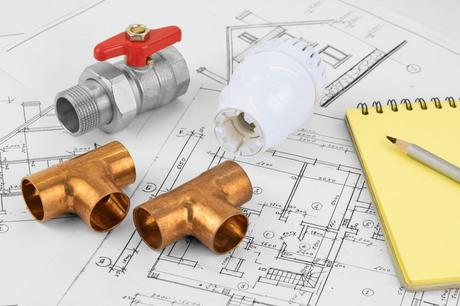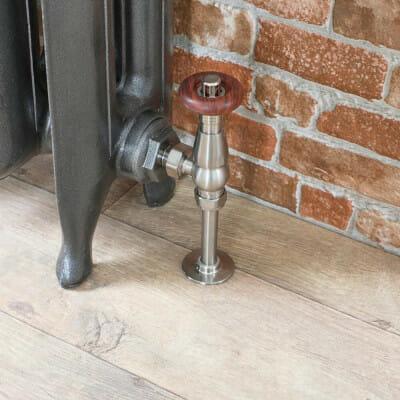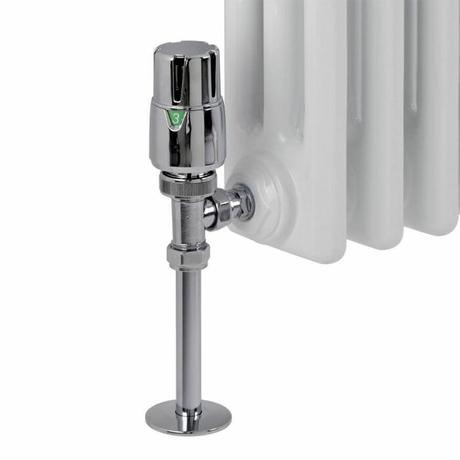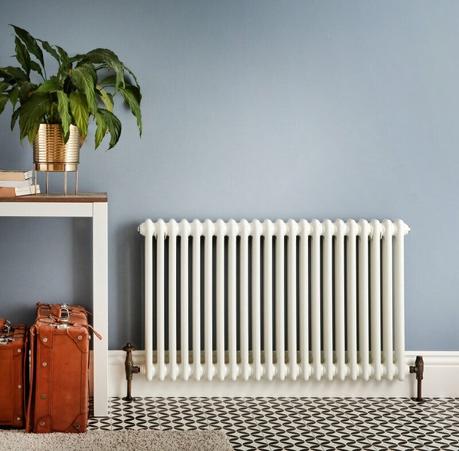Essential traditional radiator valve tips
In this article, we’ll explore the best valves for traditional radiators. It’ll help you to identify a high quality option to deliver the perfect finishing touches to your traditional style heating.
Radiator valves are key to the performance of radiators, but often a hugely underrated heating element.
Valves have a huge impact on how radiators and towel rails look and operate. They control the temperature and offer other important functionality, so you really should put a lot of stock into your radiator valve choice.
Certain radiator valves are not compatible with some radiator models, as shape, size and design – as well as the position of pipework and more – all play a large part in determining what suits what.
So let’s dive in and find the best and most practical radiator valves for traditional radiators and period-style towel rails!
The different styles of TRADITIONAL radiator valves
You might be surprised to discover the sheer variety of radiator valve types on the market. There’s all sorts of different styles, with personal preference and connection type sure to heavily influence your eventual choice.

Below is a brief overview of the main types of radiator valves available, and the environments they’re best suited to…
Traditional Straight Valves
It probably won’t be a massive surprise to learn that water flows straight via the application of straight radiator valves. There are no curves or bends, ensuring the flow of water won’t be transported at an angle.
Usually, a straight valve will feature a horizontal floor connection. They’re perfect, therefore, if your pipework travels along the wall into your radiator or equally as good if pipes emerge from the flooring and enter the bottom inlets of a heated towel rail.
Traditional Angled Valves
Surprise, surprise. An angled valve will connect your central heating system to your radiator at an angle. Typically, it will be around 90 degrees.
You’ll always require an angle to enable you to install your pipes into the inlet connection. For that reason, angled radiator valves are ideal for spaces where the pipework emanates from the wall or underneath the floorboards.
Traditional Corner Valves
Alternatively known as flat front valves, corner valves are usually selected based purely on looks. Corner radiator valves won’t extend as far away from the bottom of a radiator as much as angled valves would. Be wary though, that they can prove far more awkward to adjust as a result.
For your convenience, there’s some basic guidelines that you won’t go far wrong following when it comes to radiator valve compatibility.
Through Wall Pipework
Bottom inlets – Angled or corner valves
Side inlets – Angled or corner valves
Through Floor Pipework
Bottom inlets – Straight valves
Side inlets – Angled or corner valves
Manual or thermostatic TRADITIONAL radiator valves?
Now you know the different styles of radiator valves from an aesthetical perspective, they can be split into two main categories with relation to performance – manual and thermostatic.
But what are the specific merits of each in terms of maintenance, how they distribute heat and general usability?

Manual Radiator Valves
The performance of manual radiator valves is akin to that of a tap.
They are simply switched on to allow the water to infiltrate your radiator. They can then be turned off again when the radiator has reached your preferred temperature.
Manual valves are simple to use and very easy to maintain, but there are viable concerns regarding how they can impact energy bills. Be careful to switch them off whenever necessary to avoid spiralling heating costs.
There’s loads of traditional style manual radiator valves available, so you won’t struggle to find a stylish version to team with a traditional radiator.
Thermostatic Radiator Valves
Thermostatic radiator valves boast extremely intelligent design qualities. They enable tight control over temperature at the simple turn of a dial. This makes it much easier to keep a close gauge on energy use, and can help reduce heating bills in tow.
A thermostatic valve will take stock of room temperature before adjusting the heat output of your radiator or towel rail in accordance.
After the room has reached the required temperature, a thermostatic valve will shut off to stop water flow and prevent the radiator from getting any warmer. That functionality guarantees your radiator will never waste energy by using more heat than necessary.
Again, thermostatic radiator valves come supplied in all sorts of traditional designs in straight, angled and corner styles, so there’s appropriate options to suit any traditional radiator.
Choosing the right traditional radiator valves
Just looking at the makeup of traditional radiators, you can immediately eliminate some valve types from consideration.
For instance, none of the BestHeating collection of traditional column radiators incorporate central connections, so H-block valves are instantly unviable.
By a similar token, straight valves are unlikely to rate the best choice to accompany traditional rads. The vast majority of cast iron and traditional radiators feature side inlets, so angled or corner valves are usually a better call.
Then, you need to work out what size radiator valve you need for your traditional radiator. Not in terms of how they look – that can be decided based on your own personal preference, as can the choice of square, curved or cross-handle caps. Instead, it is imperative to consider just how big the fittings are.

Check the width of the connections in comparison with your pipework measurements. The last thing you want is for incompatible valves to halt the installation of your traditional radiator. Especially so as they tend to be heavier than other versions, it’s best to get every aspect of your trad rad fitting right the first time.
One of those key aspects is whether you deem thermostatic properties a must in your search for the right radiator valves…
Thermostatic Valves for Traditional Radiators
There’s a few factors at play in determining whether thermostatic valves are worth the investment to complete a traditional radiator.
Firstly, if you’ve already opted for SMART heating solutions, you could already have all the functionality a thermostatic radiator valve brings at your disposal.
Maintenance is another aspect to consider before committing to the purchase of thermostatic valves. You’ll have to get them thoroughly checked at least once a year to make sure they’re working to their full effect.
Valves can often be an afterthought following the purchase of a radiator, but they really shouldn’t be. Radiator valves play a vital role in making sure your radiator operates to its optimal capabilities; thermostatic models especially so.
Really, there’s few drawbacks to thermostatic valves. It’s just that you could save a bit of money with slightly cheaper alternatives if you already have SMART heating controls in effect. Plus, you might just fancy continuing the old school thread by teaming your traditional radiator with manual valves instead.
Do i have to choose traditional valves to go with my traditional radiator?
In short, no. It’s up to you what sort of radiator valves you opt for, so long as they’re compatible with your chosen radiator.
If you prefer the rounded contemporary design qualities of cylinder-shaped valves, great. If the sharp modern stylings of square valves are more your bag, so be it. And it’s not an issue if you’re seduced by the classic retro appeal of crosshead valves, which might assist in creating a more uniform authentic look – just go with what you like, after all, it’s you that’s using them and looking at them, isn’t it?!
You’ll have to envisage your traditional radiator being flanked by the valves you consider. As we alluded to, to each his own, but there are some designs that simply surely won’t mesh well.

Square valves might not be the most complementary attachment for a heavy cast iron radiator, for example, where antique style valves would provide an obvious (and more suitable) alternative.
Of course, in adding modern valves to a traditional radiator, you’re looking to inject a sense of contemporary flair to a classic design. And it is perfectly doable – just make sure your valve choice won’t lead to a completely disjointed appearance.
Top VALVE PICKS FOR TRADITIONAL RADIATORS
To make your life easier, we’ve compiled a shortlist of some top valve picks for traditional radiators. Feel free to browse our full selection of radiator valves online as well…
- Milano Windsor – Traditional Thermostatic Angled Radiator Valves Chrome (Pair)
- Milano – Antique Style Satin Thermostatic Angled Radiator Valves (Pair)
- Milano – Chrome Square Designer Angled Radiator Valves (Pair)
- Milano – Chrome Angled Radiator Valves (Pair)
- Milano Windsor – Traditional Thermostatic Corner Radiator Valves Brass (Pair)
- Milano – Traditional Chrome Angled Radiator Valves (Pair)
Selecting the right valves for traditional radiators
There you have it then. By now, you should be equipped with all the necessary know-how to select the right valves for your traditional radiators.
Remember not to underestimate the importance valves play in the performance and appearance of your radiators ahead of purchase. And after you’ve made your choice, be sure to check them out thoroughly at least annually to guarantee you’re getting the absolute best out of your home heating.
get in touch with bestheating
If you need any further advice about selecting the right radiator valves, or expert tips on all things home heating, be sure to get in touch with Best Heating. Questions can be sent via the comments section below, or through Instagram, Facebook or Twitter.


